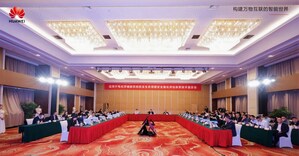Huawei's David Wang Talks 10 Wireless Industry Trends in "Roads to Mobile 2030"
DUBAI, UAE, Oct. 13, 2021 /PRNewswire/ -- During the 12th Global Mobile Broadband Forum (MBBF), Huawei Executive Director of the Board and Chairman of ICT Infrastructure Managing Board David Wang, delivered a keynote speech titled Roads to Mobile 2030: 10 Wireless Industry Trends, saying "Huawei has identified 10 wireless industry trends to define future-oriented wireless networks and prepare the industry for the Intelligent World 2030."
As he explained, by 2030, the digital and physical worlds will become deeply integrated, creating a near-real-life experience. The digital economy will also become a primary driver of the real economy, and industry will shift focus from device efficiency to decision-making efficiency. But these advances will also need us to achieve intrinsic network security and to improve energy efficiency to protect the environment through green growth.
Mobile networks will be an important part of Huawei's Intelligent World 2030 concept, and so Wang summarized the 10 trends we will see in the mobile industry over the next decade.
Trend 1: 10 Gbps for Physical-Digital Integration
In the future, digital communications will be used to expand and deepen exchanges of information between people, delivering multi-sensory experiences including hearing, sight, touch, and smell. To enable these features, mobile networks will need to support 10 Gbps at millisecond latency everywhere and transmit information in ways that are more semantically organized.
Trend 2: One Network for 100-Billion All-Scenario IoT Connections
Digital society will be reshaped by the 100 billion thing-to-thing connections cellular networks will have to support by 2030. Driven mainly by all-scenario IoT, networks will have to begin offering different types of connections services, differentiated by speed and priority requirements. This means a deterministic experience with lower latency and higher reliability must be delivered and a new form of wireless IoT that features ultra-low power consumption and passive connections must be created.
Trend 3: Satellite-Ground Collaboration for 3D Coverage
Satellite-ground collaboration will plug the gaps in wireless ground coverage and achieve three-dimensional airspace coverage, enabling communications and control for future drones and aircrafts. Mobile networks, with their exiting advanced communications technologies and multi-trillion dollar market, will also likely be used to nurture the new satellite communications technologies.
Trend 4: Integrated Sensing & Communications for True Digital Replicas
Sensing and communications will be further integrated, enabling real-time digital replication of the physical world and facilitating high-level autonomous driving and drone management. Both radio interfaces and network architectures will need to be similarly integrated and sensing resolution technology will need to advance to the centimeter level using ultra-wideband with Massive MIMO to achieve these functions.
Trend 5: Intelligence in Every Industry and Connection
Wireless networks will become fully integrated with AI technologies to enable level-5 fully autonomous driving networks, which will further support automated O&M, deliver premium experiences, and minimize carbon footprints. Future radios will also be designed with native intelligence, and smart radio algorithms will further optimize the management of channel coding and radio resource.
Trend 6: Full-Link and Full-Lifecycle Green Networks
As network traffic grows 100 times over in the next few years, there will be an equal spike in demand for solutions that reduce network energy consumption. Per-bit energy efficiency will also need to improve at a similar rate. Energy efficiency must be considered in every aspect of network design, including radio interfaces, devices, and sites. This will enable the construction of these full-link and full-lifecycle green and sustainable networks.
Trend 7: Flexible Full-Band Sub-100 GHz
By 2030, nations will need an average of 2 GHz mid-band bandwidth and over 20 GHz of bandwidths on millimeter wave to accommodate growing traffic. The industry will need to facilitate the evolution of sub-100 GHz spectrum to NR and redefine spectrum utilization using multi-band integration and other innovative technologies to achieve 10-fold spectral efficiency improvement.
Trend 8: Generalized Multi-Antenna for Reduced Per-Bit Cost
Per-bit data transmission costs will be reduced as multi-antenna technologies begin to be applied to every spectrum band and every scenario. Ultra-wideband modular antennas will support flexible combinations of multiple bands and intelligent reflecting surfaces will apply multi-antenna technologies in more scenarios to enable cloud-based, higher-performance deployment.
Trend 9: Security as the Cornerstone for a Digital Future
Intrinsic device security and intelligent and simplified security at the network layer will become increasingly important as network security and resilience come more into the global spotlight. Operators will need to provide these kinds of simplified security services via cloud-network synergy for their industry customers to promote digital transformation.
Trend 10: Mobile Computing Network for Device-Pipe-Cloud Collaboration
Future mobile networks will support more diverse services, such as the Metaverse, industrial field networks, and vehicle-to-everything (V2X) communications. This means that computing will need to be integrated with mobile networks to provide uninterrupted, high-quality services on demand as a single service model will be insufficient for building new digital platforms.
Wang rounded out his presentation by reiterating how these 10 industry trends are a bright sign that the wireless industry is moving quickly in the direction of a fully intelligent world. He closed out promising Huawei will continue to work with industry partners to define these networks of the future and make their vision of the Intelligent World 2030 a reality.
For more information, see the White Paper: 10 Wireless Industry Trends.
SOURCE Huawei






Share this article